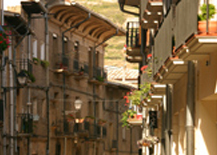
Locality: ESTELLA (31200)
Address: Barrio de San Pedro
Zone: The Central Zone
Description
The quarter of San Pedro (St Peter) of Estella, created at the end of the 11th century, offers the visitor an opportunity to experience the history of this city.
Its beautiful religious buildings such as the church of the Santo Sepulcro (Holy Sepulchre) or San Pedro de la Rúa will take you back to a time when you could imagine yourself as a pilgrim on the route towards Santiago de Compostela.
Contemplating its interesting civil buildings, among which we would highlight the Palace of the Kings of Navarra, you will be able to imagine the economic splendour that the Pilgrim’s Way brought to this city on the river Ega and you will feel like a merchant in the opulent medieval street called Rua de Curtidores (Tanners Street).
As part of his firm intention to promote the Pilgrim’s Way to Santiago, in 1090 King Sancho Ramirez decided that in the area of Lizarra, an ancient Basque settlement, one of the staging posts on the route should be established.
A castle was constructed and a walled settlement established, which was granted a Fuero (historical privilege) based on that of Jaca authorizing the installation of the Franks (men free from vassalage), nobles and clerics. This measure encouraged commercial activity and the economic and cultural enrichment of the city.
As a result, the borough of San Martín grew up on the right bank of the river Ega. It is the most monumental of all the quarters in Estella, and is located around the streets of San Nicolás and Curtidores.
It is here where the first Romanesque church in Estella was built: San Pedro de la Rúa. Crossed by the Pilgrim’s Way, the present quarter of San Pedro maintains a marked medieval atmosphere.
The visit
The visit begins in the Plaza de San Martín, with a 16th-century Renaissance fountain that is and popularly known as the fountain of ?la Mona’ or of ‘the water jets’. Around the square are the modern-day Law Courts, a 17th century Baroque building that was the town hall of Estella until the 19th century.
The three-storey Renaissance façade has classical columns and pillars with headstones. On the ?noble’ floor of the building there are two coats of arms of the city. Close by is the bridge of San Martín (‘Azucarero’), of mediaeval origin.
To the right of the square, large wide steps built in 1968 lead up towards the church of San Pedro de la Rúa, one of the most beautiful from the Romanesque period in Navarre.
It retains a multi-lobuled 13th-century doorway and a cloister from the latter part of the 12th century. At the foot of the steps in front of the church stands the imposing Palace of the Kings of Navarre from the 12th century, a unique example of Romanesque civil architecture in the region that is now home to the ?Gustavo de Maeztu’ Museum.
Of the gates entering the city, only the mediaeval Portal de Castilla remains today. It was reformed in the 16th century and is decorated with the city’s coat of arms. It stands at the end of San Nicolás street, between the Palace of the Kings of Navarre and the church of San Pedro.
The Rúa de los Curtidores is also home to some singular buildings like the Fray Diego Cultural Centre or the Palacio de San Cristobal (St Christopher), 16th-century Plateresque buildings, the Baroque palace of the Governor (built in 1613) and the bridge of the Prison of San Agustín, reconstructed in 1975.
Along this street are several Gothic arches that used to give access to shops and hospices along the Pilgrim’s Way to Santiago.
Continue along the Rúa de los Curtidores as far as the 12th-century church of the Holy Sepulchre with its marvellous 14th-century doorway. Close by stands the Gothic convent of Santo Domingo, which has been partially reconverted into a senior citizens’ residence, and the church of Santa María Jus del Castillo, with its Romanesque apse and Baroque façade, possibly built over an old synagogue.
Apart from the quarter of San Pedro, do not miss a visit to the city on the other side of the river Ega. There are many buildings with coats of arms on their façades in Calle Mayor and other interesting examples of religious architecture, such as the basilica of Our Lady of El Puy or the church of San Miguel.
If all this walking gives you an appetite, we suggest you try roast suckling pig, a typical dish of the region, together with albotes (beans), fresh asparagus, menestra (a vegetable stew), or sweets such as rocas del Puy and conchas del Camino (shells of the Pilgrim’s Way).







